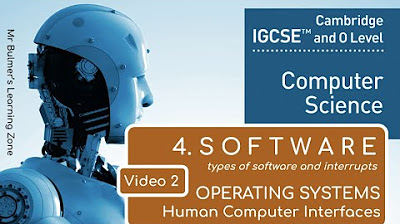IMK Temu 12
Summary
TLDRThis 12th session transcript delves into user testing and the future of user interfaces. It covers the importance of validating product requirements with real users to ensure the application meets their needs. The session explains the benefits of early testing, such as identifying issues and optimizing production costs. It also discusses qualitative and quantitative methods, including focus groups, interviews, and surveys, to gather user feedback. The future of technology is also explored, with insights into holography, advanced gadgets, digital newspapers, flexible displays, and AI-driven interactions, highlighting the continuous evolution towards more intuitive and efficient interfaces.
Takeaways
- 😀 User testing is a process to validate the usability and fit of a product or application for its users.
- 🔍 The purpose of user testing is to identify issues early on, before product launch, to save on unnecessary production costs and tailor the product to user needs.
- 📝 Two main methods of user testing are qualitative and quantitative, focusing on different aspects of user experience and data collection.
- 👥 Qualitative methods, such as focus groups and interviews, aim to understand the quality and meaning of user interactions, while quantitative methods rely on numerical data, like surveys and eye-tracking.
- 🔑 Key benefits of user testing include discovering problems early, understanding user segments, and finding suitable solutions aligned with user needs.
- 📈 Quantitative testing is characterized by its focus on numeric data and statistical analysis, which can be generalized more broadly.
- 📚 Qualitative testing offers a deeper, descriptive understanding of the user experience but is more subjective and context-specific.
- 🛠️ Techniques for user testing include traditional in-person testing, moderated online testing, and unmoderated testing where users perform tasks freely without time constraints.
- 📋 The user testing process involves planning, preparing prototypes, creating scenarios, recruiting users, recording results, analyzing findings, and determining solutions to identified problems.
- 🏆 Effectiveness, efficiency, and satisfaction are key parameters for evaluating user testing according to ISO standards, focusing on the accuracy, resource expenditure, and user comfort with the product.
- 🔮 Future technologies discussed include holography, advanced gadgets, digital newspapers, flexible displays, 3D virtual reality, AI sensing effects, sensor networks, AI robots, and advancements in human-computer interaction.
Q & A
What is the main topic of the 12th meeting discussed in the script?
-The main topic of the 12th meeting is about user testing and the future of user interfaces.
What is user testing and why is it important in product development?
-User testing is the process of evaluating the usability and functionality of a product or application from the user's perspective. It is important because it helps validate user requirements, identify issues early, and ensure that the product meets the needs of its users before launch.
What are the two main types of user testing methods mentioned in the script?
-The two main types of user testing methods mentioned are qualitative and quantitative methods.
Can you explain the difference between qualitative and quantitative user testing methods?
-Qualitative methods focus on understanding the quality and meaning of user experiences, often through focus groups, interviews, or observations. Quantitative methods focus on numerical data and statistics, such as surveys or A/B testing, to measure user preferences or behaviors.
What are some examples of qualitative user testing techniques mentioned in the script?
-Examples of qualitative user testing techniques include focus groups, interviews, forums, and user diaries.
What are some examples of quantitative user testing techniques mentioned in the script?
-Examples of quantitative user testing techniques include A/B testing, eye tracking, card sorting, and surveys or questionnaires.
What is the purpose of creating scenarios during user testing?
-Creating scenarios during user testing helps define the user flow or journey through the application, guiding the user through the various menus and actions that need to be tested.
What are the three parameters for evaluating user testing according to ISO standards mentioned in the script?
-The three parameters for evaluating user testing according to ISO standards are effectiveness, efficiency, and satisfaction.
What is the significance of the number of participants in quantitative and qualitative user testing?
-In quantitative user testing, a larger number of participants (e.g., 20 participants per research round) is preferred to obtain statistically significant results. In qualitative user testing, a smaller group of 5 to 8 users is used to gain in-depth insights through discussions or interviews.
What are some examples of future technologies discussed in the script?
-Examples of future technologies discussed include holography, advanced gadgets, digital newspapers, display glass, 3D virtual reality, sensing effects, sensor networks, AI robots, and multi-touch screens.
How does the script relate the future of technology to human interaction?
-The script suggests that future technologies will become more advanced, smaller, and more integrated into human interaction, with capabilities such as seeing, hearing, speaking, and thinking, and will often utilize movement-based interfaces for easier human interaction.
Outlines

Cette section est réservée aux utilisateurs payants. Améliorez votre compte pour accéder à cette section.
Améliorer maintenantMindmap

Cette section est réservée aux utilisateurs payants. Améliorez votre compte pour accéder à cette section.
Améliorer maintenantKeywords

Cette section est réservée aux utilisateurs payants. Améliorez votre compte pour accéder à cette section.
Améliorer maintenantHighlights

Cette section est réservée aux utilisateurs payants. Améliorez votre compte pour accéder à cette section.
Améliorer maintenantTranscripts

Cette section est réservée aux utilisateurs payants. Améliorez votre compte pour accéder à cette section.
Améliorer maintenantVoir Plus de Vidéos Connexes

HCI 2.8 Human Errors | Types | Sources | Safety with Examples | HCI

Seven Stages of Action

Pengertian dan Jenis User Interface | Analisis dan Desain Sistem

46. CAMBRIDGE IGCSE (0478-0984) 4.1 The purpose and functions of operating systems

IGCSE Computer Science 2023-25 - SOFTWARE: Video 2 - THE OPERATING SYSTEM

Connecting - Trends in UI, Interaction, & Experience Design
5.0 / 5 (0 votes)
